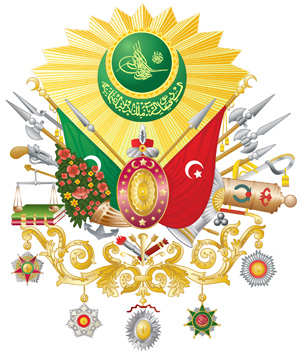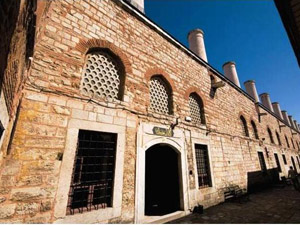
Asitane Restaurant Ottoman Palace Cuisine, Istanbul
Since 1991, Asitane has been compiling authentic recipes from a number of sources; the kitchen registers from Topkapi, Dolmabahce and Edirne Palaces, books and memoirs written by visiting overseas state officials, documents in Beyazit and Millet Libraries, and a book entitled "Bir Ziyafet Defteri" detailing the circumcision ceremony in November 1539 of Beyazid and Cihangir, the two sons of Sultan Suleyman the Magnificent.
With the aid of old Ottoman dictionaries, Asitane has archived more than 200 original recipes, and serves them in its summer and winter menus. Each year Asitane offers special menus such as the "Ramadan Menu", "Dishes from Mehmet the Conqueror's Reign" during the week celebrating Istanbul's conquest, "Fish and Sea Food Week" in the autumn, "Food from Istanbul Kitchens", "Aphrodisiacs from the Palace Menu", and a "1950's New Years Menu".
Asitane is very particular about the ingredients used in preparing these special dishes. In keeping with the original recipes, the restaurant obtains its bulgur and other cereals from Urfa, pistachios, dovme nisasta and oil from Gaziantep, lamb from Tekirdag, smoked Cerkez cheese from Adapazari, hunnap from Finike, Kanlica and oyster mushrooms from Bolu and Kastamonu, geese from Eskisehir Alpu, pomegranate and grape extract from Antakya, and specially produced olive oil from Ayvalik region.
Each dish on the menu comes with its original Ottoman name and date.
 |
The Ottoman Cuisine
Turkish cuisine is renowned as one of the world's best. It is considered to be one of the three main cuisines of the world because of the variety of its recipes, its use of natural ingredients, its flavours and tastes which appeal to all palates and its influence throughout Europe, Asia, the Middle East and Africa. The cuisine originated in central Asia, the first home of the Turks, and then evolved with the contributions of the inland and Mediterranean cultures with which Turks interacted after their arrival in Anatolia.
Turkish cuisine is in a sense a bridge between far-Eastern and Mediterranean cuisines, with the accent always on enhancing the natural taste and flavour of the ingredients. There is no one dominant element in Turkish cuisine, like sauces in French and pasta
in Italian cuisines.
While the Palace cuisine was developing in Istanbul, local cuisines in Anatolia were multiplying in several regions, all displaying different geographical and climactic characteristics. These cuisines, after remaining within regional borders for centuries, are now being transplanted to the big cities and their suburbs as a consequence of large scale urbanisation and migration towards new urban centres. As a result, the national Turkish cuisine has been enriched by the contribution of a great number of local recipes.
Turkey is self-sufficient in food production and produces enough for export as well. This means that Turkish food is usually made from fresh, local ingredients and is all the tastier for it.
A main meal will usually start with soup and the meze, a variety of small cold and hot dishes which are made for sharing. In many restaurants a waiter will bring these round on a tray for you to inspect and make your choice. Tarama salad, cacik (taziki), dolma (vine leaves or peppers stuffed with rice), börek (pastries) , arnavut ciğeri (cubes of fried liver) are amongst the many types of mezes found in most of the restaurants.
The main course is usually meat or fish. Turks always eat bread with their meal and main courses are usually served with rice. Typically a salad will be offered as a side dish. Lamb is the most popular meat and prepared in a variety of ways. Turks traditionally are fond of stews called sulu yemek or ev yemeği (home cook) and therefore there are many restaurants offering these foods which are usually displayed in the entrance of the restaurant in large containers.
Fish and seafood restaurants are widely found in Istanbul, in the other big cities and in the coastal resorts. Mostly fish is simply grilled to bring out its natural flavour and there is a wide variety of seafood meze including midye tava (fried mussels), kalamar (calamari), midye dolma (mussels in shells stuffed with seasoned rice).
 |
Ottoman Palace Kitchens
Kitchen alleyway from Halva Kitchen to Royal Storeroom. |
The Imperial Kitchen
The importance of culinary art to the Ottoman Sultans is evident to every visitor to Topkapı Palace. The huge kitchens were housed in several buildings under ten domes. By the 17th century some thirteen hundred kitchen staff were housed in the Palace. Hundreds of cooks, specializing in different categories, such as soups, pilafs, kebabs, vegetables, fish, breads, pastries, candy and helva, syrups and jams, and beverages, fed as many as ten thousand people a day, and in addition, sent trays of food to others in the city as a royal favor. The importance of food has also been evident in the structure of the Ottoman military elite, known as the Janissaries. The commanders of the main divisions were known as the Soupmen, other high ranking officers included the Chief Cook, the Sclullion, the Baker, and the Pancake Maker, though their duties had little to do with food. The huge cauldron used to make pilaf had a special symbolic significance for the Janissaries, and was the focal point of each division. The kitchen was at the same time the center of politics, for whenever the Janissaries demanded a change in the Sultan's Cabinet, or the head of a grand vizier, they would overturn their pilaf cauldron. "Overturning the cauldron," is an expression still used today to indicate a rebellion in the ranks. It was in this environment that hundreds of Sultan's chefs, who dedicated their lives to their profession, developed and perfected the dishes of the Turkish cusine, which was then adopted in from the Balkans to sautern Russia, and reaching as far as North Africa. Istanbul was then the capital of the world and had all the prestige, so its ways were imitiated. At the same time, it was supported by an enormous organization and infrastructure which enabled all the treasures of the world to flow into it.
The provinces of the vast empire were integrated by a system of trade routes with caravanserais for refreshing the weary merchants and security forces. The spice Road, the most important factor in culinary history, was under the full control of the Sultan. Only the best ingredients were allowed to be traded under the strict standards established by the courts. Guilds played an important role in the development and sustenance of the cuisine. These included hunters, fishermen, cooks, kebab cooks, bakers, butchers, cheese makers and yoghurt merchants, pastry chefs, pinkle makers, and sausage merchants. All of the principal trades were believed to be sacred and each guild traced its patronage to the saints. The guilds set price and quality controls. They displayed their products and talents in spectacular parades through Istanbul streets on special occasions, such as the circumcision festivities for the Crown Prince or religious holidays. Following the example of the Palace, all of the grand Ottoman houses boasted elaborate kitchens and completed in prepairing feasts for each other as well as for the general public. In fact, in each neighborhood, at least one household would open its doors to anyone who happened to stop by for dinner during other festive occasions. This is how the traditional cuisine evolved and spread, even to the most modest corners of the country.
The center of Ottoman cuisine was Istanbul, the capital, where the imperial court and the metropolitan elites established a refined culinary tradition bringing together elements of regional cuisines
from across the empire:
...despite the disintegration of the Ottoman political empire, we can still see the survival of a large region which could be called the Ottoman culinary empire. The Balkans, Greece, Anatolia and the Fertile Crescent... are common heirs to what was once the Ottoman life-style, and their cuisines offer treacherous circumstantial evidence of this fact. Of course, they represent at the same time a good deal of local or regional culinary traditions. Besides, one should not forget that it is typical of any great cuisine in the world to be based on local varieties and on mutual exchange and enrichment among them, but at the same time to be homogenized and harmonized by a metropolitan tradition of refined taste.
This diverse cuisine was amalgamated and honed in the Imperial Palace's kitchens by chefs brought from certain parts of the empire to create and experiment with different ingredients. These chefs were tested and hired by their method of cooking rice, a simple dish. They were brought over from various places for the express purpose of experimenting with exotic textures and ingredients and inventing new dishes. Each cook specialized in specific tasks. All dishes intended for the sultan were first passed by the palate of the Chesnidjibashi, or imperial food taster, who tested the food for both poison and taste. The creations of the Ottoman palace's kitchens also filtered to the common population, for instance through Ramadan events, and through the cooking at the yalis of the pashas, and from there on to the people at large.
Excluding its successor Turkish cuisine, the Ottoman cuisine has strongly influenced other cuisines such as Persian cuisine, Armenian cuisine, Cypriot cuisine, that of the Balkans (Greek cuisine, Bulgarian cuisine, Romanian cuisine, Macedonian cuisine, Albanian cuisine, Serbian cuisine, Bosnian cuisine), and that of the Middle East (Levantine cuisine, Lebanese cuisine, Syrian cuisine, Iraqi cuisine, Jordanian cuisine, Palestinian cuisine, and Israeli cuisine).
Some of the more extravagant dishes remained as palace specialities and have had only limited diffusion:
• Roasted Pigeon
• Ayva (Quince) Kalye
• Kavun Dolma (Stuffed Melon)
 |
A Repertoire of Ingredients
A survey of the types of dishes according to their ingredients may be helpful to explain the basic structure of Turkish cuisine. Otherwise there may appear to be an overwhelming variety of dishes, each with a unique combination of ingredients and its own way of preparation and presentation. All dishes can be conveniently categorized: grain-bazed, grilled meats, vegetables, seafood, desserts and beverages. Before describing each of these categories, some general comments are necessary. The foundation of the cuisine is based on grains (rice and wheat) and vegetables. Each category of dishes contains only one or two types of main ingredients.
Turks are purists in their culinary taste, that is, the dishes are supposed to bring out the flavour of the main ingredient rather than hiding it under sauces or spices. Thus, the eggplant should taste like eggplant, lamb like lamb, pumpkin like pumpkin, and so on. Contrary to the prevalent Western impression of Turkish food, spices and herbs are used very simply and sparingly. For example, either mint or dill weed are used with zucchini, parsley is used with eggplant, a few cloves of garlic has its place in some cold vegetable dishes, and cumin is sprinkled over red lentil soup or mixed in ground meat making "köfte" (meat balls). Lemon and yoghurt are used to complement both meat and vegetable dishes as well as to balance the taste of olive oil or meat. Most desserts and fruit dishes do not call for any spices. So their flavors are refined and subtle. There are major classes of meatless dishes. When meat is used, it is used sparingly. Even with the meat kebabs, the "pide" or the flat bread is the largest part of the dish alongside vegetables or yoghurt.
Turkish cuisine also boats a variety of authentic contributions to desserts and beverages. For the Turks, the setting is as the food itself. Therefore, food-related places need to be considered, as well as the dining protocol. Among the"great-food places" where you can find ingredients for the cuisine are the weekly neighborhood markets ("pazar") and the permanent markets. The most famous one of the latter type is the Spice Market in Istanbul. This is a place where every conceivable type of food item can be found, as it has been since pre-Ottoman times. This is a truly exotic place, with hundreds of scents rising from stalls located witin an ancient domed building, which was the terminus for the Spice Road. More modest markets can be found in every city center, with permanent stalls for fish and vegetables. The weekly markets are where sleepy neighborhoods come to life, with the villagers setting up their stalls before dawn in designated area to sell their products. On these days, handicrafts, textiles, glassware and other household items are also among the displays at the most affordable prices. What makes these places unique is the cacophony of sounds, sights, smells and activity, as well as the high quality of fresh food, which can only be obtained at the pazar. There is plenty of haggling and jostling as people make their way through the narrow islewhile vendors compete for their attention.
|